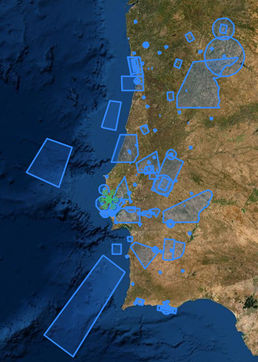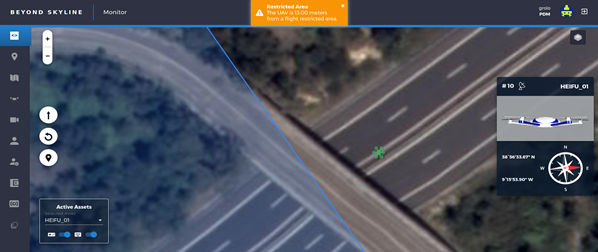Safety Information¶
The HEIFU® is equipped with state-of-the-art technology and it was developed having safety as one of its primary concerns.
However, the HEIFU® is not a toy and should not be handled as one. Individuals under the age of 16 are not be allowed to manipulate this drone, as failure to comply with some safety requirements can result in serious injury for the person handling the drone and others around. It can also result in severe damage to the drone or even complete loss of the equipment. Moreover, starting from 2021, new rules developed by EASA were released and apply to the usage of drones across Europe. Please check European Commission Delegated Regulation 2019/945 and confirm that you have the necessary conditions to fly, especially if the flight you are about to perform doesn’t comply with the conditions stated for the “open-category”, which exempt you from having to submit official operational documentation in order to get the needed authorization to fly (https://www.easa.europa.eu/domains/civil-drones/drones-regulatory-framework-background/open-category-civil-drones). Moreover, please ensure you have an insurance for your drone with a weight above 250g as it is now mandatory for all of EASA Member States. So please consult the national regulation.
Also, please read carefully the following safety guidelines before you start using your drone, as these will surely help a safer and more enjoyable flight.
Note
These are only safety guidelines and can be superseded by local laws and regulations if there are any.
General risks concerning the usage of flying vehicles¶
When using flying vehicles, the user should be aware that this type of vehicles can inherently pose a set of risks related to the condition of flying, namely:
Spinning propellers: in order to be able to fly, the HEIFU® has six rotors. Close contact with the spinning propellers when they are moving can result in serious cuts, damage of goods and damage of the HEIFU® itself and shall always be avoided;
Collision: whether with ground objects (buildings, power lines or other infrastructures) or flying ones (planes, birds, other flying beings), there are always a probability of collision that shall be thoroughly considered before flying as this can cause serious damage to the HEIFU® and the both;
Fall: Even considering the redundancy of the HEIFU® flying sensors and actuators in order to guarantee that it doesn’t fall, there is always a risk of falling, as there is with any flying object. So, flying above crowds, lines of water or other sensitive objects shall always be avoided;
Legal boundaries: : Every country has its no-fly zones. It is very important that the operator does everything in his/her power to avoid these no-fly zones, as they usually mark high-risk or restricted air space.
The following sections describe in detail how to avoid these risks.
General safety guidelines¶
Weather: Try to always fly only in moderate weather conditions. If the weather is not ideal but you still need to fly, please refer to appendix A.1 Technical specifications (under environmental specifications) to check on the drone limits and ensure that it is safe to fly. You should never try to fly under severe weather conditions like heavy wind or rain, fog, snow and lightning.
Fire accident: Unless you have fire extinguisher equipment, you should not come close to the equipment or try to extinguish the fire in the case of a fire accident;
Before flight checklist: Always, use the provided pre-flight checklist (section Before flight checklist) to confirm that everything is in order before the flight.
Keep safe distance: The HEIFU® is a multirotor flying device and as such, it is important to keep a safe distance from the drone. You should always keep a safe distance from it (at least 3m) if it is activated and ready to take off.
Local regulations: Respect the local laws and regulations, namely the ones regarding flight limits and no-fly zones, as non-compliance with these regulations can result in civil and/or criminal prosecution. It is of particular importance that you don’t fly near airports, helipads or military facilities.
Rotors stop: Never stop the rotors during flight unless in an emergency situation (see section Operator Control failsafe), as the drone will most certainly crash.
Manual operation safety guidelines¶
While flying in manual operation mode, please keep the following guidelines in mind, unless you have an authorization to fly under a category other than EASA open-category.
Line-of-sight (LoS): Always keep the drone within line-of-sight at all times and at an altitude below 120m AGL. Open-field: You should try to always fly in open-field, with good satellite visibility, to ensure that the drone has the best instrumentation conditions for its flight. You must also keep a distance of at least 150m from residential areas and far (at least 30m) from other people.
Always alert: Maintain a good surveillance of the drone at all times during the flight. Also, ensure that you are not under the influence of alcohol, drugs or other substances that might affect your capabilities.
Physical obstacles: Always ensure that the drone is not flying over power lines, tall trees and other obstacles. Also, you should avoid bodies of water, as the drone is not prepared to land on water.
Power lines: Areas with high-voltage power lines are areas to be avoided, as the strong magnetic fields can influence and confuse the sensors on-board.
Note
If the flight controller senses a low battery level, it beeps and immediately tries to land wherever it is. This is a safety procedure and it is normal. However, you should ensure that the drone is always flying above open terrain, so it can land safely.
Maintenance safety guidelines¶
You should respect the maintenance guidelines of your drone to ensure that it is always in good shape for flying. The following are general maintenance safety guidelines. Please refer to Device Care for further maintenance instructions.
Spare parts: Always use original HEIFU® spare parts (please refer to Beyond Vision’s technical support contacts are in Contact Us to check how to order spares). Moreover, you should always ensure that you only use parts that are in good condition. Namely, the usage of aged, broken or chipped propellers puts the whole equipment at risk, as these may fail during the flight.
Batteries: Caution must be taken not to overcharge or overdischarge the batteries. You should also make sure that the batteries of the drone and the Operator Control are fully-charged before each flight. You should not use batteries that already failed or were overdischarged as this increases the chances of failure during the flight, putting the equipment at risk. You should also always use batteries provided by Beyond Vision . The batteries used in HEIFU® have a specific casing that is designed to fit inside the tray.
Warning
Please be aware that failure to comply with the safety guidelines and recommendations can affect not only yourself, but others around you. Ensuring that you do whatever you can to avoid an accident is part of your civil responsibilities.
No-fly zones¶
Every country has zones that cannot be overflown, either because of safety and/or because of security issues. The beXStream® platform enables the upload of these no-fly zones so that it can instruct the HEIFU® to avoid them. It also warns the user that the drone cannot fly over that area. As such, the HEIFU® will not takeoff inside a no-fly zone and if it enters one while flying, it will land automatically.

Fig. 18 Example of No-fly Zones (Portugal)¶
While flying, if the HEIFU® approaches a no-fly zone (closer than 1000 meters), the user will get the following warning on beXStream®:

Fig. 19 Approaching a no-fly zone warning (within 1000 meters)¶
If it still approaches that zone and gets within 100 meters from it, the platform will display a warning like the one below:

Fig. 20 Approaching a no-fly zone warning (within 100 meters)¶
If it enters the no-fly zone, it will land the HEIFU® automatically and display the following error on the platform.

Fig. 21 Entered a no-fly zone error¶
Warning
Please be aware that if the drone lands inside a no-fly zone (e.g. military area), you may lose it, as it is the responsibility of the pilot to ensure that the drone doesn’t fly over those areas.
Note
If your country’s no-fly zones are still not on beXStream® platform, please prepare a .kml file with the coordinates of the no-fly zones and contact Beyond Vision’s Technical Support to upload them onto the beXStream® platform.
For further information regarding applicable limitations and obligations of UAV under European law in European space, please check EASA info .